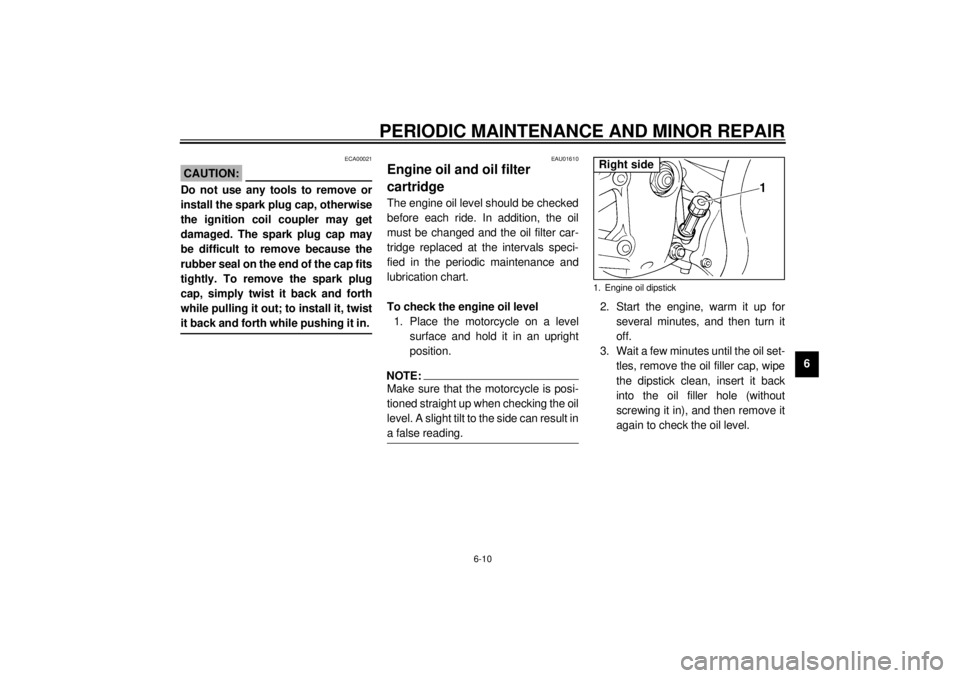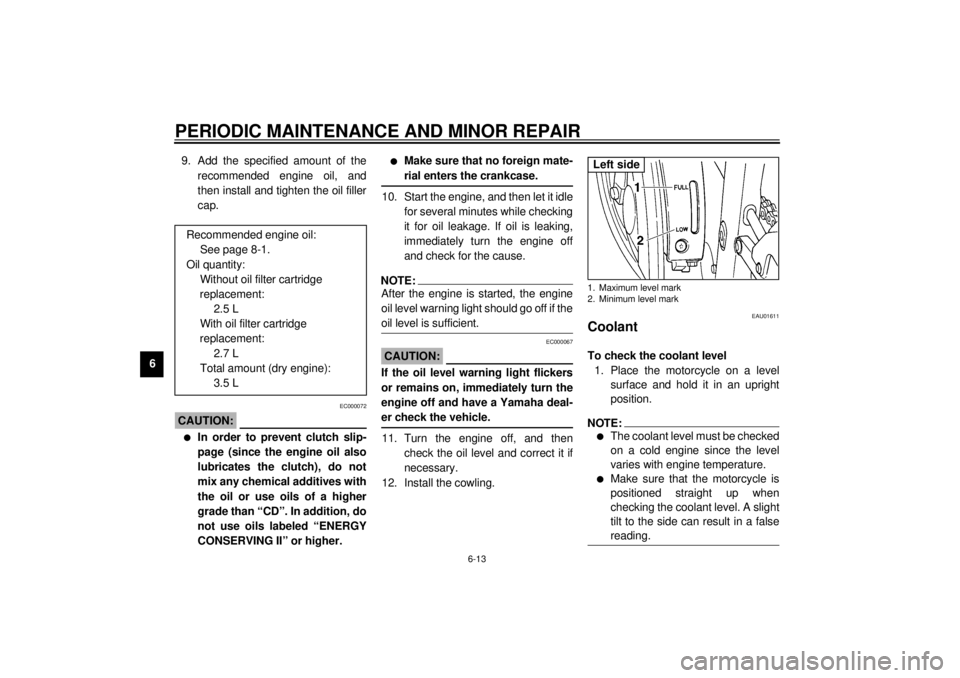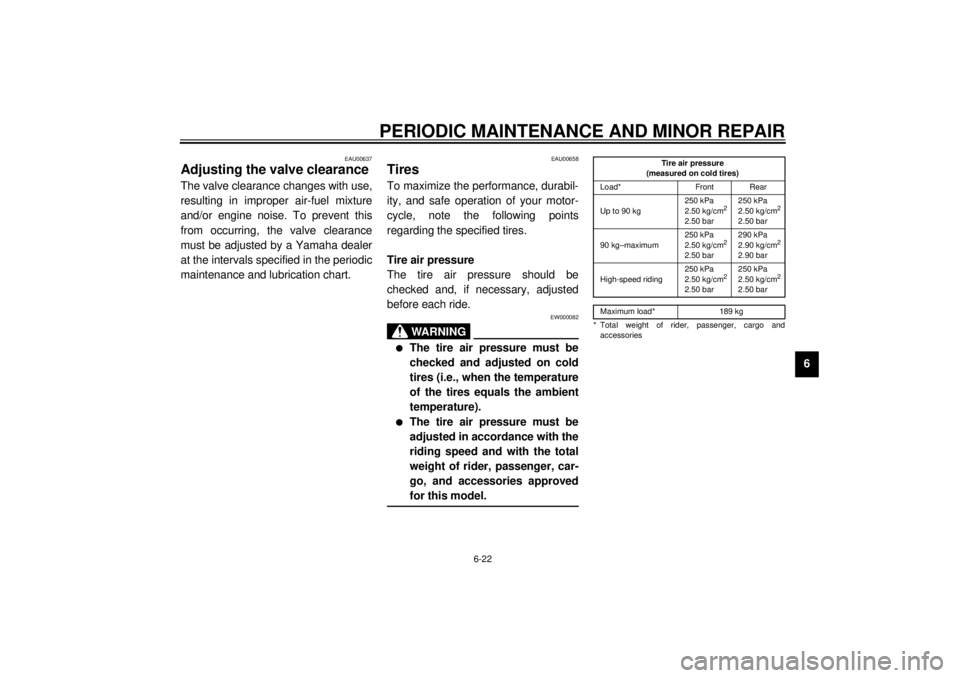check engine YAMAHA YZF-R6 2001 User Guide
[x] Cancel search | Manufacturer: YAMAHA, Model Year: 2001, Model line: YZF-R6, Model: YAMAHA YZF-R6 2001Pages: 118, PDF Size: 12.83 MB
Page 60 of 118

PERIODIC MAINTENANCE AND MINOR REPAIR
6-9
6
EAU01639
Checking the spark plugs The spark plugs are important engine
components, which should be checked
periodically, preferably by a Yamaha
dealer. Since heat and deposits will
cause any spark plug to slowly erode,
they should be removed and checked
in accordance with the periodic mainte-
nance and lubrication chart. In addition,
the condition of the spark plugs can re-
veal the condition of the engine.The porcelain insulator around the cen-
ter electrode of each spark plug should
be a medium-to-light tan (the ideal col-
or when the motorcycle is ridden nor-
mally), and all spark plugs installed in
the engine should have the same color.
If any spark plug shows a distinctly dif-
ferent color, the engine could be defec-
tive. Do not attempt to diagnose such
problems yourself. Instead, have a
Yamaha dealer check the motorcycle.
If a spark plug shows signs of electrode
erosion and excessive carbon or other
deposits, it should be replaced.
Before installing a spark plug, the spark
plug gap should be measured with a
wire thickness gauge and, if necessary,
adjusted to specification.Clean the surface of the spark plug
gasket and its mating surface, and then
wipe off any grime from the spark plug
threads.
NOTE:@ If a torque wrench is not available when
installing a spark plug, a good estimate
of the correct torque is 1/4–1/2 turn
past finger tight. However, the spark
plug should be tightened to the speci-
fied torque as soon as possible. @
a. Spark plug gap
Specified spark plug:
CR10EK (NGK)
Spark plug gap:
0.6–0.7 mm
Tightening torque:
Spark plug:
12.5 Nm (1.25 m·kg)
E_5mt.book Page 9 Monday, September 18, 2000 9:08 AM
Page 61 of 118

PERIODIC MAINTENANCE AND MINOR REPAIR
6-10
6
ECA00021
CAUTION:@ Do not use any tools to remove or
install the spark plug cap, otherwise
the ignition coil coupler may get
damaged. The spark plug cap may
be difficult to remove because the
rubber seal on the end of the cap fits
tightly. To remove the spark plug
cap, simply twist it back and forth
while pulling it out; to install it, twist
it back and forth while pushing it in. @
EAU01610
Engine oil and oil filter
cartridge The engine oil level should be checked
before each ride. In addition, the oil
must be changed and the oil filter car-
tridge replaced at the intervals speci-
fied in the periodic maintenance and
lubrication chart.
To check the engine oil level
1. Place the motorcycle on a level
surface and hold it in an upright
position.NOTE:@ Make sure that the motorcycle is posi-
tioned straight up when checking the oil
level. A slight tilt to the side can result in
a false reading. @
2. Start the engine, warm it up for
several minutes, and then turn it
off.
3. Wait a few minutes until the oil set-
tles, remove the oil filler cap, wipe
the dipstick clean, insert it back
into the oil filler hole (without
screwing it in), and then remove it
again to check the oil level.1. Engine oil dipstickRight side
E_5mt.book Page 10 Monday, September 18, 2000 9:08 AM
Page 64 of 118

PERIODIC MAINTENANCE AND MINOR REPAIR
6-13
69. Add the specified amount of the
recommended engine oil, and
then install and tighten the oil filler
cap.
EC000072
CAUTION:@ l
In order to prevent clutch slip-
page (since the engine oil also
lubricates the clutch), do not
mix any chemical additives with
the oil or use oils of a higher
grade than “CD”. In addition, do
not use oils labeled “ENERGY
CONSERVING II” or higher.
l
Make sure that no foreign mate-
rial enters the crankcase.
@10. Start the engine, and then let it idle
for several minutes while checking
it for oil leakage. If oil is leaking,
immediately turn the engine off
and check for the cause.NOTE:@ After the engine is started, the engine
oil level warning light should go off if the
oil level is sufficient. @
EC000067
CAUTION:@ If the oil level warning light flickers
or remains on, immediately turn the
engine off and have a Yamaha deal-
er check the vehicle. @11. Turn the engine off, and then
check the oil level and correct it if
necessary.
12. Install the cowling.
EAU01611
Coolant To check the coolant level
1. Place the motorcycle on a level
surface and hold it in an upright
position.NOTE:@ l
The coolant level must be checked
on a cold engine since the level
varies with engine temperature.
l
Make sure that the motorcycle is
positioned straight up when
checking the coolant level. A slight
tilt to the side can result in a false
reading.
@
Recommended engine oil:
See page 8-1.
Oil quantity:
Without oil filter cartridge
replacement:
2.5 L
With oil filter cartridge
replacement:
2.7 L
Total amount (dry engine):
3.5 L
1. Maximum level mark
2. Minimum level markLeft side
E_5mt.book Page 13 Monday, September 18, 2000 9:08 AM
Page 65 of 118

PERIODIC MAINTENANCE AND MINOR REPAIR
6-14
6 2. Check the coolant level in the
coolant reservoir.
NOTE:@ The coolant should be between the
minimum and maximum level marks. @3. If the coolant is at or below the
minimum level mark, remove the
coolant reservoir cover by remov-
ing the bolts, open the reservoir
cap, add coolant to the maximum
level mark, close the reservoir
cap, and then install the reservoir
cover and bolts.
EC000080
CAUTION:@ l
If coolant is not available, use
distilled water or soft tap water
instead. Do not use hard water
or salt water since it is harmful
to the engine.
l
If water has been used instead
of coolant, replace it with cool-
ant as soon as possible, other-
wise the engine may not be
sufficiently cooled and the cool-
ing system will not be protected
against frost and corrosion.
l
If water has been added to the
coolant, have a Yamaha dealer
check the antifreeze content of
the coolant as soon as possible,
otherwise the effectiveness of
the coolant will be reduced.
@
EW000067
WARNING
@ Never attempt to remove the radia-
tor cap when the engine is hot. @NOTE:@ The radiator fan is automatically
switched on or off according to the
coolant temperature in the radiator. If
the engine overheats, see page 6-46
for further instructions. @
1. Bolt (´ 2)Left side
Coolant reservoir capacity:
0.44 L
E_5mt.book Page 14 Monday, September 18, 2000 9:08 AM
Page 66 of 118

PERIODIC MAINTENANCE AND MINOR REPAIR
6-15
6
EAU01612
To change the coolant
1. Place the motorcycle on a level
surface and let the engine cool if
necessary.
2. Remove panel C, and cowlings A
and B. (See pages 6-6–6-8 for
panel and cowling removal and in-
stallation procedures.)
3. Place a container under the en-
gine to collect the used coolant.
4. Remove the radiator cap.
EW000067
WARNING
@ Never attempt to remove the radia-
tor cap when the engine is hot. @
5. Remove the water pump drain bolt
to drain the water pump housing.
6. Loosen the clamp screw, and then
disconnect the radiator hose to
drain the radiator.
7. After the coolant is completely
drained, thoroughly flush the cool-
ing system with clean tap water.
8. Connect the radiator hose, and
then tighten the clamp screw.
9. Install the coolant drain bolt, and
then tighten it to the specified
torque.
NOTE:@ Check the washer for damage and re-
place it if necessary. @
1. Radiator capRight side
1. Water pump drain bolt
2. Clamp screwRight side
Tightening torque:
Coolant drain bolt:
12 Nm (1.2 m·kg)
E_5mt.book Page 15 Monday, September 18, 2000 9:08 AM
Page 68 of 118

PERIODIC MAINTENANCE AND MINOR REPAIR
6-17
6
EC000080
CAUTION:@ l
If coolant is not available, use
distilled water or soft tap water
instead. Do not use hard water
or salt water since it is harmful
to the engine.
l
If water has been used instead
of coolant, replace it with cool-
ant as soon as possible, other-
wise the engine may not be
sufficiently cooled and the cool-
ing system will not be protected
against frost and corrosion.
l
If water has been added to the
coolant, have a Yamaha dealer
check the antifreeze content of
the coolant as soon as possible,
otherwise the effectiveness of
the coolant will be reduced.
@16. Install the radiator cap, start the
engine, let it idle for several min-
utes, and then turn it off.17. Remove the radiator cap to check
the coolant level in the radiator. If
necessary, add sufficient coolant
until it reaches the top of the radia-
tor, and then install the radiator
cap.
18. Start the engine, and then check
the vehicle for coolant leakage. If
coolant is leaking, have a Yamaha
dealer check the cooling system.
19. Install the panel and the cowlings.
EAU03726
Checking the air filter element The air filter element should be
checked at the intervals specified in the
periodic maintenance and lubrication
chart. Check the air filter element more
frequently if you are riding in unusually
wet or dusty areas.
1. Remove the rider seat. (See
page 3-13 for rider seat removal
and installation procedures.)
2. Remove the fuel tank bolts and lift
the fuel tank as shown.1. Bolt (´ 2)
E_5mt.book Page 17 Monday, September 18, 2000 9:08 AM
Page 70 of 118

PERIODIC MAINTENANCE AND MINOR REPAIR
6-19
66. Pull the air filter element out.
7. Check the condition of the air filter
element and replace it if it is dam-
aged or excessively dusty.8. Insert the element into the air filter
case.
EC000082
CAUTION:_ l
Make sure that the air filter ele-
ment is properly seated in the
air filter case.
l
The engine should never be op-
erated without the air filter ele-
ment installed, otherwise the
piston(s) and/or cylinder(s) may
become excessively worn.
_9. Install the air filter case cover by
installing the screws.
10. Connect the fuel sender coupler
and the hoses, turn the fuel cock
lever to “ON”, place the fuel tank in
the original position, and then in-
stall the bolts.
EW000131
WARNING
_ Make sure that the fuel hoses and
vacuum hose are properly connect-
ed and routed, and not pinched. Re-
place any damaged hoses. _11. Install the rider seat.
1. Air filter elementE_5mt.book Page 19 Monday, September 18, 2000 9:08 AM
Page 71 of 118

PERIODIC MAINTENANCE AND MINOR REPAIR
6-20
6
EAU01335
Air intake duct Check that the screen of the intake
duct is not blocked. Clean the screen if
necessary.
EAU00630
Adjusting the carburetors The carburetors are important parts of
the engine and require very sophisti-
cated adjustment. Therefore, most car-
buretor adjustments should be left to a
Yamaha dealer, who has the neces-
sary professional knowledge and expe-
rience. The adjustment described in
the following section, however, may be
serviced by the owner as part of routine
maintenance.
EC000095
CAUTION:@ The carburetors have been set and
extensively tested at the Yamaha
factory. Changing these settings
without sufficient technical knowl-
edge may result in poor perfor-
mance of or damage to the engine. @
1. Air intake duct
E_5mt.book Page 20 Monday, September 18, 2000 9:08 AM
Page 72 of 118

PERIODIC MAINTENANCE AND MINOR REPAIR
6-21
6
EAU00632
Adjusting the engine idling
speed The engine idling speed must be
checked and, if necessary, adjusted as
follows at the intervals specified in the
periodic maintenance and lubrication
chart.
1. Start the engine and warm it up for
several minutes at 1,000–
2,000 r/min while occasionally rev-
ving it to 4,000–5,000 r/min.NOTE:@ The engine is warm when it quickly re-
sponds to the throttle. @
2. Check the engine idling speed
and, if necessary, adjust it to spec-
ification by turning the throttle stop
screw. To increase the engine
idling speed, turn the screw in di-
rection
a. To decrease the engine
idling speed, turn the screw in
direction
b.NOTE:@ If the specified idling speed cannot be
obtained as described above, have a
Yamaha dealer make the adjustment. @
EAU00635
Adjusting the throttle cable
free play The throttle cable free play should
measure 6–8 mm at the throttle grip.
Periodically check the throttle cable
free play and, if necessary, have a
Yamaha dealer adjust it.
1. Throttle stop screw
Engine idling speed:
1,250–1,350 r/min
a. Throttle cable free play
E_5mt.book Page 21 Monday, September 18, 2000 9:08 AM
Page 73 of 118

PERIODIC MAINTENANCE AND MINOR REPAIR
6-22
6
EAU00637
Adjusting the valve clearance The valve clearance changes with use,
resulting in improper air-fuel mixture
and/or engine noise. To prevent this
from occurring, the valve clearance
must be adjusted by a Yamaha dealer
at the intervals specified in the periodic
maintenance and lubrication chart.
EAU00658
Tires To maximize the performance, durabil-
ity, and safe operation of your motor-
cycle, note the following points
regarding the specified tires.
Tire air pressure
The tire air pressure should be
checked and, if necessary, adjusted
before each ride.
EW000082
WARNING
@ l
The tire air pressure must be
checked and adjusted on cold
tires (i.e., when the temperature
of the tires equals the ambient
temperature).
l
The tire air pressure must be
adjusted in accordance with the
riding speed and with the total
weight of rider, passenger, car-
go, and accessories approved
for this model.
@
CE-01E
CE-07E
Tire air pressure
(measured on cold tires)
Load* Front Rear
Up to 90 kg250 kPa
2.50 kg/cm
2
2.50 bar250 kPa
2.50 kg/cm
2
2.50 bar
90 kg–maximum250 kPa
2.50 kg/cm
2
2.50 bar290 kPa
2.90 kg/cm
2
2.90 bar
High-speed riding250 kPa
2.50 kg/cm
2
2.50 bar250 kPa
2.50 kg/cm
2
2.50 bar
Maximum load* 189 kg
* Total weight of rider, passenger, cargo and
accessories
E_5mt.book Page 22 Monday, September 18, 2000 9:08 AM